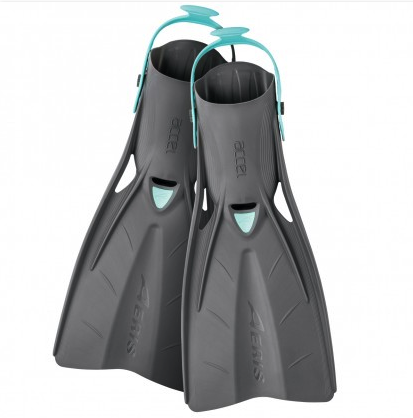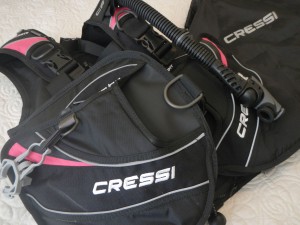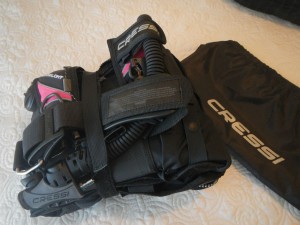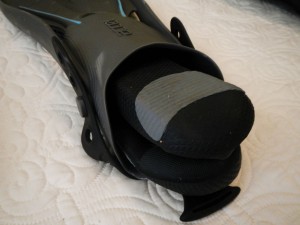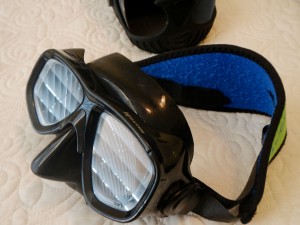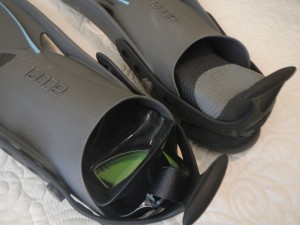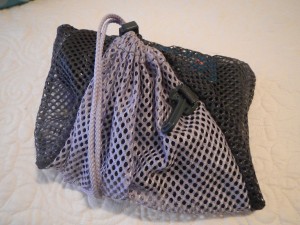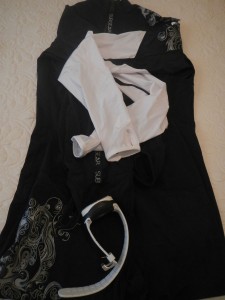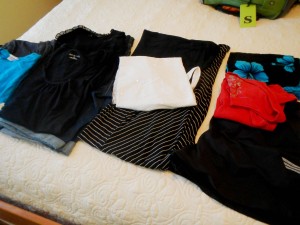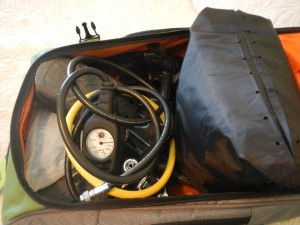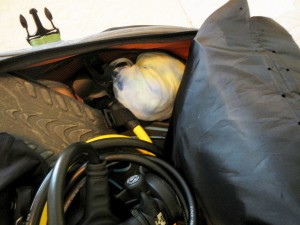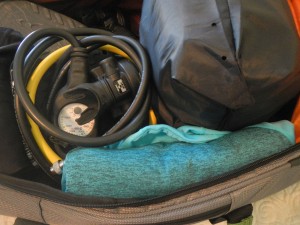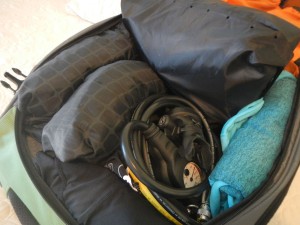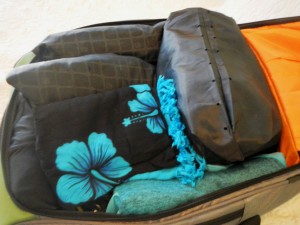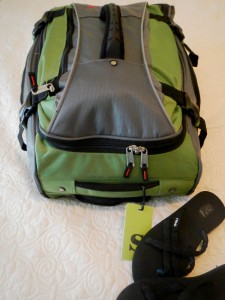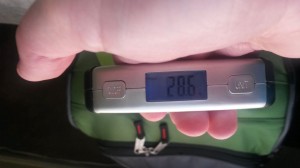How can a woman pack for a tropical scuba diving trip without checking a bag? It’s not easy, and you have to plan ahead. Lots of men will tell you how to pack your bag for a dive trip, but really, they don’t understand. Not to generalize, but they typically don’t pack makeup and hair supplies. They’ll wear the same two pairs of shorts all week. Their TSA quart bag contains deodorant and shave gel. So what can you do to be a minimalist packer?
Download a printable packing list that you can use to do your packing.
Your scuba gear will be the heaviest and bulkiest items that you pack. What type of gear that you own depends on what kind of diver that you are. If you consider yourself to be a warm water diver and will fly and travel to most of your dive destinations, invest in travel gear. If you are mostly a local diver that occasionally travels for tropical diving, it might not be a worthwhile investment.
Scuba Gear
For this article, we will be packing the following scuba gear:
- Buoyancy Control Device (BCD)
- Regulator
- Dive Computer
- Fins/Snorkel/Mask
- Dive Accessories
Cressi Travelight BCD
You might pay a little bit more at your local dive shop, but you’re keeping that local business open and you get to try it on before you buy it. We have seen this BCD for as low as $329.
ScubaPro MK11/S360 Regulator
Cressi Leonardo Dive Computer
If you’re looking for more, why get a *slightly* better computer? Go all the way. Get something that you can see easily in all conditions. Get wireless air integration. Get a system that will let you monitor your buddy’s air if they have the same system. Or get something inexpensive that will get the job done for a Nitrox diver.
Aeris Accel Fins
Travel Snorkel
Also, make sure that you know your destination. For example, if you’re going to Cozumel, there’s no shore diving allowed on the protected reef, but there is some great snorkeling. In this case, the travel snorkel isn’t going to work. Pack a full-size snorkel for shore activities.
Mask
Dive Accessories
- Boots (if you do not have a full-foot fin)
- Wetsuit, shorty, or skin
- eRDP – If your computer goes out, you can technically calculate your dives and keep diving
- Earplugs
- Flashlights and batteries
- Defog
- Ear drops
- GoPro camera and accessories
- Dive Log book – Skip it. Take a picture of relevant pages, including your last logged dive.
Packing List
For this article, we will be packing the following non-scuba items:
Clothing
- Hoodie – Bring a sport hoodie to use if you get cold on the boat or in the evenings
- Yoga pants – Bring comfy pants to wear in the resort or over your suit on the boat for night dives
- Underwear
- Socks – Wear them with tennis shoes or walking around your room
- Cute shorts/capris – Bring wrinkle-resistant shorts that can be worn to lunch/dinner at least twice before washing
- Cute tops – Bring some cute tops for dinner with the group that mix/match well
- Cute sandals – Black Teva Women’s Olowahu Flip Flops are great. They are comfortable and can be dressed up or down. This will be your new favorite all-purpose flip flop. It’s also available with a 1.75-inch heel.
- Sarong – Use as a swimsuit cover or as a skirt/dress at dinner
- Swimsuits
- Quick-dry shorts- Bring some board shorts to wear over your swimsuit on the boat, or for walking back to your room. You can hang quick dry shorts in your bathroom or balcony to dry every evening.
- Cover tops – bring a tee or tank to wear over your swimsuit or to relax in your room. Again, quick-dry is the preferred fabric.
Wear on the plane:
- Jeans – Wear this heavy/bulky item on the plane. These can be worn for dinner or cooler evenings
- Plain tee
- Sweater – bring a simple black wrap sweater that can work with any outfit
- Tennis shoes – for walking through the airport and on any hikes/excursions
Toiletries
The following liquids are included in the article TSA Liquids Quart bag:
- Shower gel (optional) – Use the hotel soap
- Shampoo (optional) – Make sure that your resort has shampoo and skip it
- Conditioner (optional) – Skip it
- Facial Care (Clinique)
- face wash – green tube
- astrigent – small pink bottle
- face lotion – yellow tube
- eye cream – small tub
- aging serum – silver sample pump
- Big Sexy Root Pump – red travel aerosol can available at Ulta
- Liquid Wax – Pureology product pumped into a small tub
- Blistex
- Concealer
- Toothpaste – Save up the freebies you get at the dentist office twice a year
- Nail polish to touch up toes – Get some OPI minis!
- Perfume sample
- Ear drops
- Face sunscreen – Put it in a Go Toob
- Defog
- Bug spray
Other Toiletries
- Hair accessories – Bring bobby pins/ponytail holders
- Deodorant
- Make up – non liquid
- Comb/brush
- Hair clip – Bring this to clip up your hair, and to clip together hotel curtains to keep the sun out
- Feminine supplies
- Face wipes
- BioFreeze packets – Get travel packets of Biofreeze for sore dive muscles and after massages
- Toothbrush
- Razor (use soap for shaving or buy shaving cream on location)
- Floss
- Cotton Balls
- Q-Tips
Travel
- Trash bags
- Ziploc bags
- Moleskin for blisters
- Bandaids
- Airline tickets
- Passport
- Wristlet wallet
- cash for shopping/tipping
- ID and Bank/Credit Cards
- Dive cards
- Empty Nalgene bottle – if you like to mix in drink packets with your water, that way you don’t have to buy 16 oz water bottles
- Crystal Light packets (pack in the bottle)
- Protein bars
- Fruit snacks
- Gum/mints
- Sunglasses & case
- Medicine: prescript, med info, OTC, and vitamins
- Motion sickness meds
- Immodium
- Hand fan
- Nail kit
- Chapstick
- Small umbrella
Electronics
- Phone & charger – Often, you can use your phone while traveling and stuck in the airport, but you don’t want to use anything but wifi internationally.
- External Battery – Use an external battery to charge your phone, tablet, and other USB devices. I recommend the Anker Astro E5 15,000 mAh battery:
- Extra earphones – bring headphones with a microphone and a case, such as this iKross earbud set.
- iPad
- charger
- SD reader – to get photos/video from your camera to your iPad for editing and sharing (See the existing article)
- Dive camera (mentioned in the scuba gear)
- extra batteries
- chargers
- 7 SD cards – bring one for travel days and one each for each vacation day
- Hotel Wifi Hotspot (optional) – since some hotels provide free ethernet in the room, but no wifi, a device such as the TP-Link TL-WR700N Wireless Portable Router allow you to make your own wireless hotspot. Find out the internet situation before you pack.
- MacBook Air & charger – Decide whether you need a laptop, but if you do, the MacBook Air is a great choice. I highly recommend the Apple Refurbished program.
- Work key generator – If you need to access your work network while you travel, bring your USB key or key generator
- Power Converters (optional) – if you are traveling internationally, make sure that you have the power converters that you need, such as this Australia/China converter.
Shopping
- Sunscreen
- Aloe
- Shaving cream
- Bottled water – if you need bottled water, buy it in the cheapest method you can per oz or mL, then carry/use your Nalgene bottle.
Bags
It’s important to have the right bags. You want to minimize bag weight and maximize interior space. You also need a durable bag – especially the wheels!
Dive Bags
It might be worthwhile to pack a mesh gear bag. Sometimes, dive resorts keep and move your gear for you. But even if you only need to carry your gear down to the dive shop, it’s nice to have a mesh bag. It’s especially nice if you have to lug and rinse your own gear. A good quality and affordable mesh bag is the Akona Mesh Duffel Bag.
Carry On Bag
For this article, we will be using the Athalon Luggage 21 Inch Hybrid Travelers Bag (in green).
Personal Item
For this article, we will be using the Lesportsac Large Tote. It is 22″ x 13″, but is squishable, so it fits under the seat. The 13″ allows space for your feet beside the bag. As a bonus, this bag weighs around 1 pound.
Pack Your Bags
The key to being able to pack everything you need in your bags is how you pack.
Carry-On Bag
How you pack your bag is important.
Step 1 – Gather all of the items that you will be packing in your carry-on.
Roll your travel BCD as tight as you can:
Stuff both boots into one fin to save space:
If you use a slap strap on your mask, flip the strap around to protect the glass and put it inside your other fin:
Put your non-liquid scuba accessories in a mesh bag:
Roll your dive computer inside your dive skin (or shorty/wetsuit):
Lay out your clothes to make sure that you have everything on the list:
Roll up your outfits and put them into little nylon shoe bags that you get for free at events or with nice shoes:
Step 2: Pack larger items first with smaller items around them used as filler
Put your fins in your carry on first:
If you place your rolled, bagged swimsuits under the top fin, you save the wasted space.
Add your tightly-rolled and bagged BCD at the base of the carry on and wrap your regs tightly in the middle of the suitcase or bag:
This packing method means that your heaviest item is in the bottom of your rolling bag, which will keep it from tipping over in the airport. It also protects your regs by having them in the center of the bag.
Stuff your tiny bag of undies in the empty spot by your fins:
Add your hoodie down one side, and your dive skin along the top (left here):
Add your two rolled bags of nice clothing:
Place your folded sarong on your regs:
Place your yoga pants and tee on top of that, then put your rolled shorts and tank used for a swimsuit cover in the lid:
Compress everything and carefully zip your bag:
It’s stuffed. You will not have room to slip in extra items and you will have to pack just as carefully when you come home. Do not try to use the outside pockets, because it will make the bag oversized and you might be forced to check it.
Now your carryon bag comes in at 28.6 pounds:
Step 3: Put everything else in your tote bag
Pack your toiletries, dive accessories, and electronics in your tote bag.




